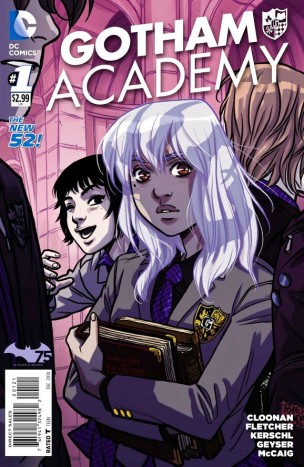DC Comics’ Batman line is in the midst of a creative renaissance. With the launches of “Gotham Academy,” “Arkham Manor,” and “Gotham by Midnight,” the Batman line is, for the first time since DC’s 2011 reboot, shifting its focus away from grim stories exclusively about Batman and his comrades, allowing creators more freedom to experiment and explore different genres. For “Gotham Academy,” that means turning a spotlight on some of the ordinary citizens of Gotham City, namely students at the titular boarding school.
“Gotham Academy” is produced by the creative team of co-writers Becky Cloonan and Brenden Fletcher, artist Karl Kerschl, and colorists Geyser and Dave McCaig. Having won the Eisner Award—the comic book equivalent of an Oscar—for Best Single Issue (or One Shot) in 2013 for her self-published comic, “The Mire,” and having received the honor in 2012 of being the first woman to draw a full issue of “Batman,” Cloonan is arguably the most prolific creator of the series. However, Cloonan is more known for her artwork than her writing; aside from swapping roles with writer Brian Wood for one issue of their Eisner-nominated series, “Demo,” Cloonan has never written a comic without also providing its artwork.
Thankfully, Cloonan doesn’t seem to have had any trouble with the transition from writer/artist to co-writer; she and Fletcher have given the first issue a solid script. “Gotham Academy” is noticeably different from Cloonan’s previous work. Whereas “The Mire” and its companion pieces, “Wolves” and “Demeter,” were medieval horror comics, “Gotham Academy” is a fun young adult (YA) series set in modern times.
This first issue feels very much like a tour of the academy itself, giving readers a sense of how things work there and the role that each character plays in the academy’s makeup. Though readers don’t get to know most of the cast quite as well as they do Olive Silverlock, the comic’s troubled main protagonist, the brief glimpses they are given of other characters are rich with detail, such as Pomeline Fritch’s disdainful reference to Olive’s Wayne Foundation scholarship and Maps’ casual mention of being “ninth level” and fighting a “Yothg’nki wizard” in what must have been some sort of roleplaying game. The characters also feel like actual citizens of Gotham City; they are not dazzled by Gotham’s eccentricities like we are. “It’s just the Bat-Signal,” Olive says at the end of the issue. “Same old thing as every other night.”
Cloonan and Fletcher clearly intend to tell many stories in “Gotham Academy.” Though the main plot of this issue is self-contained, various mysteries are seeded throughout. While many feel like they will be resolved in the next few issues—the possible haunting in the academy’s North Hall being one—there are many more that feel as though some mysteries will be around for the long term: for example, why Olive despises Batman and what happened to her over the summer. All of the mysteries are intriguing, though, and there are certainly enough introduced in this issue to keep readers interested for a long time to come.
That being said, this issue’s writing isn’t without flaws. For instance, while Olive’s internal monologue is a helpful way to get us inside of her head and provide exposition, there are points where it feels heavy-handed. Additionally, there are several moments that feel like they are just repeating information that has already been communicated. Thankfully, though, there are no serious missteps.
This issue’s artwork is nothing short of stunning. When Cloonan was announced as a co-writer but not the artist for the book, I was disappointed. Kerschl, however, is a more-than-worthy replacement. Kerschl’s vibrant, expressive figures, combined with his detailed backgrounds, beautifully painted by McCaig and Geyser, make the artwork look as if it were taken directly from animation cells. Even though all of the students wear the Gotham Academy uniform, Kerschl manages to make them distinct from one another. Each student’s design suits hir personality, and they are all given little touches that highlight aspects of their characterization, such as Kyle’s ever-present tennis visor. Lastly, Kerschl’s layouts are wonderfully experimental, keeping each page feeling fresh and exciting. Unlike those of many artists who try to break out of the typical layout formulas, Kerschl’s unique layouts add to the story, rather than make it more confusing, which is certainly a testament to his storytelling ability.
“Gotham Academy” #1 is an incredibly charming introduction to a brand-new series. Detached from main Batman continuity, it is the perfect book for those completely new to comics or those who are looking for something a bit different from the rest of what DC is currently publishing. Hopefully, its solid cast and gorgeous artwork will be around for many more issues.
